Experiencias excepcionales
- Diseñadas por nosotros, un grupo líder y de confianza en el sector de viajes
- Con guías expertos y amables
- Muy bien valoradas por los clientes

Esta experiencia cumple con los criterios del Consejo Mundial de Turismo Sostenible. Al elegir esta experiencia, proteges los lugares que te gustan, cuidas el medioambiente y colaboras con las comunidades locales
Hemos diseñado nuestras experiencias con esmero para ayudarte a sacarle el máximo partido a cada viaje.
This history fest kicks off in style with a visit to Pompeii. You can still see the remains of the town, much of it more or less unchanged 2,000 years after it was buried under volcanic ash. After a guided tour and a light lunch, you'll then visit the summit of Mount Vesuvius. Alessio, one of our expert local guides, says, ‘On 24 August in 79AD, Vesuvius blew its top and covered Pompeii in ash and pumice. Accounts from the time say that the volcano had been showing signs of an imminent eruption for a few days, and fortunately many people had already evacuated the area.'
Because Pompeii remained buried in ash for so many centuries, you can still see the remarkable ruins of temples, villas and streets, seemingly frozen in time. It's one vast archaeological site, and new discoveries are still being made today. Alessio adds, ‘Pompeii is a site that evolves from month to month. Even for a guide like me, there's often something new to discover as parts of the site are opened or newly excavated.'
After a light lunch, you'll head up Vesuvius. As for the fiery mountain itself, this one's up alongside Krakatoa in the notoriety stakes – it's the only active volcano on mainland Europe, though the last eruption was in 1944. As you can imagine, the views from the top over the Bay of Naples and the city are phenomenal. Alessio says, ‘Some 600,000 people live near Mount Vesuvius, me included – it might seem a risky place to live but, for everyone's safety, the volcano is constantly monitored.'